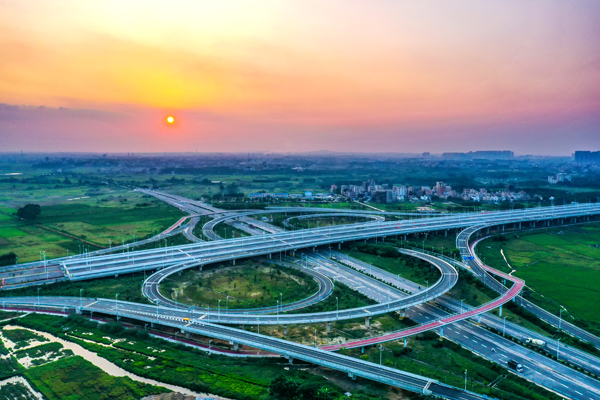Modern transportation advances geographical, commercial advantages
Construction of the Zhanjiang undersea tunnel has been completed with a shield tunneling excavation length of 4,546 meters, according to local authorities.
The tunnel, a part of the overall construction of the Guangzhou-Zhanjiang high-speed railway, has a total length of 9,640 meters. The shield tunnel section accounts for 7,551 meters.
The recently completed project has prepared the foundation for the high-speed railway to operate as scheduled, local officials said.
With a total length of 401 kilometers, the Guangzhou-Zhanjiang high-speed railway has a designed speed of 350 km per hour and is scheduled to open in 2025.
Once running, the railway will enable the travel time between the downtown areas of Guangzhou and Zhanjiang to be 90 minutes. This will, in turn, incorporate Zhanjiang into the coordinated development of the Guangdong-Hong Kong-Macao Greater Bay Area.
Zhanjiang began its high-speed railway construction when the Zhanjiang section of the Shenzhen-Zhanjiang high-speed railway launched in July 2018. It added Zhanjiang to the "three-hour high-speed railway transportation circle" in the Bay Area and made it the third national railway hub city in Guangdong.
Located at the junction of Guangdong, the Guangxi Zhuang autonomous region and Hainan, Zhanjiang is playing a central role in the national construction of a comprehensive transport network.

Zhanjiang Avenue, the city's fourth north-south urban expressway, is opened at the end of 2022. GUO LONGBI/FOR CHINA DAILY
In recent years, Zhanjiang has been working to build a national comprehensive transportation hub. It has continued to improve the network through planning, constructing a hub and enhancing infrastructure for land, sea and air transport.
In December, Zhanjiang Avenue, the city's fourth north-south urban expressway, was opened. Extending 22 km, the avenue serves about 2.4 million residents and contributes to Zhanjiang's construction of an urban transportation network.
In March 2022, the Zhanjiang Wuchuan Airport was launched, which is the first 4E airport in western Guangdong. 4E refers to the second-best ranking in China's five-tier airfield system. The airport assists air traffic in areas including Zhanjiang, Maoming, Yangjiang in western Guangdong, and Beihai and Yulin in eastern Guangxi.
As a coastal city, Zhanjiang has accelerated the construction of a port-based national logistics hub. Zhanjiang Port is a world-class deep-water port, serving as a national port and is the only one in South China that can accommodate vessels up to 400,000 dead-weight tons.
In 2022, Zhanjiang Port completed a total cargo throughput of 250 million tons, and a container throughput of 1.53 million twenty-foot equivalent units, up 9.3 percent year-on-year.
Xuwen Port in Zhanjiang boasts the world's largest cargo-passenger roll-on roll-off ferry terminal. Opened in September 2020, it shortened the travel time across the Qiongzhou Strait by more than one-third.
This year, Zhanjiang will promote transport network construction by implementing 60 projects with a planned investment of 16.9 billion yuan ($2.44 billion). This will establish a modern, multilayered transport system with a focus on major ports, its airport and highways as its backbone, Zeng Jinze, mayor of Zhanjiang, said while addressing the city's government work report.
Zeng said Zhanjiang will upgrade its port capacity, leverage the advantages of its deep-water port and accelerate the construction of related infrastructure.
It is necessary to improve the port logistics system, develop multimodal transportation and improve the ports' capabilities, Zeng said.
According to the city government, a slew of engineering projects — including terminals and waterways at port areas, a regional air transport hub and airport expressways, and a land transportation network — will be built or improved this year.



 Print
Print Mail
Mail

